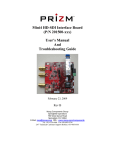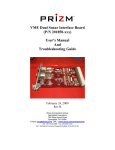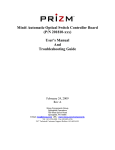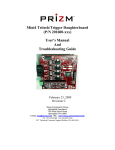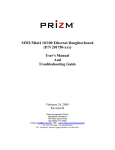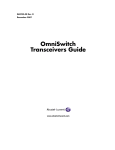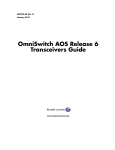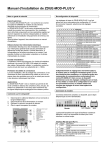Download 201630-xxx Mini4 Dual Sonar Interface Board Manual, rev B
Transcript
Mini4 Dual Sonar Interface Board (P/N 201630-xxx) User’s Manual And Troubleshooting Guide February 23, 2009 Rev B Moog Components Group Springfield Operations 750 West Sproul Road Springfield, PA 19064 E-Mail: [email protected] URL: www.moog.com/components Tel: 610-328-4000 Fax 610-605-6216 24/7 Technical Customer Support Hotline: 610-605-6101 Moog Components Group 201630-xxx Mini4 Dual Sonar Board Manual, Preliminary 2/23/09 MANUAL REVISION HISTORY REVISION DATE BY NUMBER REASON FOR REVISION Preliminary 10/26/06 GSG ORIGINAL A 4/19/09 GSG UPDATED B 2/23/09 IB Updated contact information to reflect Moog Components Group TABLE OF CONTENTS 1 MINI4 DUAL SONAR BOARD, P/N: 201630-XXX....................................................................... 3 1.1 1.2 1.3 MINI4 DUAL SONAR BOARD REVISION HISTORY: ........................................................................... 3 MINI4 DUAL SONAR BOARD DASH (-) NUMBER DEFINITIONS......................................................... 3 MINI4 DUAL SONAR BOARD OPERATION: ....................................................................................... 3 1.3.1 1.3.2 1.3.3 1.3.4 1.3.5 1.3.6 1.3.7 Dual Sonar Board Indicators and Controls: .................................................. 4 Mini4 Dual Sonar Board Specifications:...................................................... 11 Mini4 Dual Sonar Board Dimensions: ......................................................... 11 Dual Sonar Board Power Requirements: ..................................................... 11 Power Section Testing................................................................................... 11 Optical Section Testing ................................................................................. 12 Sonar Testing ................................................................................................ 12 1.4 STACK MINI4 SYSTEM INSTALLATION CHECKOUT PROCEDURE .................................................... 13 1.4.1 1.4.2 Diagnostics Overview ................................................................................... 13 Required Communications Hardware for Diagnostics................................. 13 Page 2 of 14 Moog Components Group 1 201630-xxx Mini4 Dual Sonar Board Manual, Preliminary 2/23/09 Mini4 Dual Sonar Board, P/N: 201630-xxx The Prizm Mini4 Dual Sonar Board provides two independent fiber optic links to remote the Reson 8xxx and Simrad EM3002 single/dual beam sonars. The Dual Sonar Board can be jumper selected to support both single-ended (single coax) Reson sonars and differential (dual coax) Simrad sonars. This board only provides for the sonar’s uplink (subsea to surface) data link, the downlink (surface to subsea) control link must be handled through another separate multiplexer. The control link for the Reson and Simrad sonars may require specific electrical protocols (i.e. RS-232, RS-485, RS-422 or other) and the sonar manufacturer’s interface manual should be consulted. The Dual Sonar Board can be jumper configured to operate as either a subsea or surface interface board, so can be used as spare for either location. The optical modules used on the board (pluggable small-form-factor (SFP)) are inherently bi-directional and care must be taken to ensure the correct optical port (either TX or RX) is connected, depending on the board configuration and system location. While the optical module’s receiver will operate on all of the 16 CWDM wavelengths (1270 to 1610nm), the module’s transmitter only emits at a single wavelength so care must be taken to ensure the correct wavelength is used. The Dual Sonar Board supports PMON II diagnostics through the RS-485 diagnostics cable. Diagnostics will display the optical parameters from both of the SFP modules and will also show the sonar activity (both into and out of the board) on PMON II. Note: to acquire diagnostics from the remote Dual Sonar Board, the board must be either stacked on top of a Mini4 Video Input or Output board or have its 3-pin Phoenix diagnostics cable connected to a Mini4 Video Input or Output board. 1.1 Mini4 Dual Sonar Board Revision History: The Mini4 Dual Sonar Board has gone through the following printed circuit board (PCB) and Assembly revisions: PCB Revision A/Assembly Revision A Original design.. 1.2 Mini4 Dual Sonar Board Dash (-) Number Definitions The Mini4 Dual Sonar Board has a Dash Number appended to the part number. This Dash Number identifies the specific board configurations: -001 original configuration. 1.3 Mini4 Dual Sonar Board Operation: Each independent sonar link has two 50-ohm SMB coaxial connectors. These connectors will be active as inputs or outputs depending on the jumper settings. For single-ended (single coax) sonars, only the top SMB connector will be active (labeled IN/OUT A+ or IN/OUT B+). For differential (dual coax) sonars, both of the connectors will be used. The sonar fiber links are identified as link “A” or “B”. Page 3 of 14 Moog Components Group 201630-xxx Mini4 Dual Sonar Board Manual, Preliminary 2/23/09 There is single green 2-pin Phoenix connector on the on the right side of the board for supplying the board with +5VDC. Pin 1 is the +5VDC input and pin 2 is the ground. There is single black 3-pin Phoenix connector on the on the right side of the board for RS485 diagnostics. Pin 1 is the RT+ signal, pin 2 is the ground/shield and pin 3 is the RTsignal. A Prizm Diagnostics cable can be connected directly to this 3-pin connector or through a stacked Mini4 Video Input or Output board. NOTE: To complete the RS-485 diagnostics link from the surface to the subsea boars, the Dual Sonar Board must be stacked onto a Mini4 Video Input or Output board to complete the link over the multiplexer’s fiber. 1.3.1 Dual Sonar Board Indicators and Controls: LEDS: There are 4 surface mount vertical LED indicators on the top of the board and 4 surface mount right-angle LED indicators on the bottom of the board. Top of Board LED Indication D1 (Green) Located at the top left of the board serves as an indicator that +5V DC is available to the board. Supply voltage 5V to the board is selected via the placement of fuse F1 (or F2 or F3). D2 (Green) Located on the top center of the board, labeled ‘FIBR A’, provides an indication that the transceiver module has detected the presence of an input signal on the fiber link. When ‘ON’ indicates that this board has a good level of received optical power from the remote unit A. NOTE: IF BOARD IS CONFIGURED AS AN INPUT, THEN THIS LED WILL BE OFF. D3(Green) Located on the top center of the board, labeled ‘FIBR B’, provides an indication that the transceiver module has detected the presence of an input signal on the fiber link. When ‘ON’ indicates that this board has a good level of received optical power from the remote unit B. NOTE: IF BOARD IS CONFIGURED AS AN INPUT, THEN THIS LED WILL BE OFF. D5(Green) Located at the bottom right of the board serves as an indicator that +3.3V DC is operational on the board. 3.3V is generated by the on-board DC-DC converter at U9. Bottom of Board LED Indication D10 (Green) ‘ON’ when sonar data is being sent out of the board on link A D15 (Green) ‘ON’ when sonar data is being received into the board on link A D16 (Green) ‘ON’ when sonar data is being sent out of the board on link B D19 (Green) ‘ON’ when sonar data is being received into the board on link B Page 4 of 14 Moog Components Group 201630-xxx Mini4 Dual Sonar Board Manual, Preliminary 2/23/09 FUSES: There are four fuses for this board, all fuses are the self-resetting PTC type and will not require replacement by the user. F1: 2.6 Amp PTC, +5VDC input fuse at J8 F2: 2.6 Amp PTC, +5VDC input fuse for Diag header at J4 – NOT PLACED F3: 2.6 Amp PTC, +5VDC input fuse for Daughterboard header at J3 – NOT PLACED F4: 0.5 Amp PTC, +5VDC output fuse for LED header – NOT PLACED SWITCHES: There are no switches on this board. CONNECTORS: The fiber optic modules are identified as connectors, J1: Optics module “A” J2: Optics module “B” There are four SMB coaxial connectors on the left side of the board for connecting the sonar coaxial cables. J5: “IN/OUT A+”, single-ended input/output or differential positive input/output J7: “IN/OUT A-”, not used if single-ended or differential negative input/output J9: “IN/OUT B+”, single-ended input/output or differential positive input/output J10: “IN/OUT B-”, not used if single-ended or differential negative input/output There are two daughterboard stacking connectors. J3 Daughterboard Header VDC Supply RXD_DB GND RXC_DB RCV LINK RXD_DB2 1 3 5 7 9 11 o o o o o o o o o o o o 2 4 6 8 10 12 VDC Supply TXD_DB GND TXC_DB Future TXD_DB2 Page 5 of 14 Moog Components Group J4 201630-xxx Mini4 Dual Sonar Board Manual, Preliminary Diagnostics Header RT+ GND GND +5V +5V 1 3 5 7 9 o o o o o o o o o o 2 4 6 8 10 RTGND GND +5V +5V There are two Phoenix pluggable connectors J6: J6 3-pin Phoenix, RS-485 Diagnostics Diagnostics Connector o 1 o 2 o 3 RT+ GND RT- J8: 2-pin Phoenix, +5VDC power entry J8 o 1 o 2 +5VDC Power Connector +5V GND There is one 16-pin ribbon header for remote LED diagnostics display J11: J11 16-pin ribbon, LED diagnostics Led Status Connector GND FIBER_A_LED * IN_ACT_A_LED * OUT_ACT_A_LED No connect No connect No connect No connect 1 3 5 7 9 11 13 15 o o o o o o o o o o o o o o o o 2 4 6 8 10 12 14 16 PTC FUSE with +5VDC FIBER_B_LED IN_ACT_B_LED * OUT_ACT_B_LED * No connect No connect No connect No connect NOTE 1: J11 header is located at the bottom center side of the board. Pin 1 is the upper right pin – as identified by a square pad. NOTE 2: Signals are active low. NOTE *: These signals not available on PCB Rev A boards. Page 6 of 14 2/23/09 Moog Components Group 201630-xxx Mini4 Dual Sonar Board Manual, Preliminary 2/23/09 There is one header for programming the Lattice programmable device J12: ISP programming header, do not use ISP Header J12 +3.3V TCK N/C GND 1 3 5 7 o o o o o o o o 2 4 6 8 TMS TDI TDO NOTE: J12 to be used only by PRIZM. JUMPER POSTS: The board contains jumper posts to allow the user to configure each link for input or output and for single-ended or differential signals. Other jumpers are used for factory programming or testing and should not be move or changed. For link “A”, jumper posts JP1, 2, 7, 8, 10, 12, 21 are selectable. (PIN 1 DENOTED BY SQUARE PCB PAD) JP1: Input/Output select for IN/OUT A+ connector (J5) 1 o IN | 2 o for INPUT 1 o IN 2 o for OUTPUT | 3 o OUT 3 o OUT JP2: Output A CD/Mute Selection 3 o 2 o 3 o Disable Mute 1 o JP7: Single-ended/Differential select for link A 3 oS | 2 o for Single-ended 1 oD 2 o for CD Mute | 1 o 3 oS 2 o | 1 oD Page 7 of 14 3 o | 2 o for LSI Mute 1 o Moog Components Group JP8: 2 o | 1 o 201630-xxx Mini4 Dual Sonar Board Manual, Preliminary Laser enable/disable select for link A 2 o to enable laser to disable laser 1 o JP10: Input/Output select for IN/OUT A- connector (J7) 3 o OUT 3 o OUT | 2 o for OUTPUT 2 o for INPUT | 1 o IN 1 o IN JP12: Input A CD/Mute Selection 1 o Disable Mute 2 o 1 o | 2 o for CD Mute JP21: Input/Output select for link A 1 o IN | 2 o for INPUT 3 o OUT 1 o IN 2 o for OUTPUT | 3 o OUT For link “B”, jumper posts JP9, 13, 15, 17, 18, 19, 20 are selectable. (PIN 1 DENOTED BY SQUARE PCB PAD) JP13: Input/Output select for IN/OUT B+ connector (J9) 1 o IN | 2 o for INPUT 3 o OUT 1 o IN 2 o for OUTPUT | 3 o OUT Page 8 of 14 2/23/09 Moog Components Group 201630-xxx Mini4 Dual Sonar Board Manual, Preliminary JP15: Output B CD/Mute Selection 3 o 2 o 3 o Disable Mute 1 o 2 o for CD Mute | 1 o 3 o | 2 o for LSI Mute 1 o JP18: Single-ended/Differential select for link B 3 oS | 2 o for Single-ended 3 oS 2 o | 1 oD 1 oD JP9: 2 o | 1 o Laser enable/disable select for link B 2 o to enable laser to disable laser 1 o JP17: Input/Output select for IN/OUT B- connector (J10) 3 o OUT 3 o OUT | 2 o for OUTPUT 2 o for INPUT | 1 o IN 1 o IN JP19: Input B CD/Mute Selection 1 o Disable Mute 2 o 1 o | 2 o for CD Mute Page 9 of 14 2/23/09 Moog Components Group 201630-xxx Mini4 Dual Sonar Board Manual, Preliminary JP20: Input/Output select for link B 1 o IN | 2 o for INPUT 3 o OUT 1 o IN 2 o for OUTPUT | 3 o OUT For factory configuration, jumper posts JP3-6, 11, 14, 16 are selectable. (PIN 1 DENOTED BY SQUARE PCB PAD) JP3: Cypress “A” microprocessor programming header – do not use JP4: RS-485 Diagnostics enabling header 1 3 5 7 o==o 2 o o 4 To enable “A” Only o==o 6 o o8 1 3 5 7 o o2 o== o 4 To enable “B” Only o o6 o== o 8 1 3 5 7 o==o 2 o==o 4 To enable both “A” and “B” o==o 6 o==o 8 JP5: Cypress “B” microprocessor programming header – do not use JP6: Eye monitor, “A” Output 1 o test point 2 o GND JP11: Eye monitor, “A”Input 1 o test point 2 o GND Page 10 of 14 2/23/09 Moog Components Group 201630-xxx Mini4 Dual Sonar Board Manual, Preliminary 2/23/09 JP14: Eye monitor, “B” Output 1 o test point 2 o GND JP16: Eye monitor, “B” Input 1 o test point 2 o GND 1.3.2 Mini4 Dual Sonar Board Specifications: Number of Sonar links: 2 per board Sonar type supported: Reson 8xxx or Simrad EM3002 Data rates supported: Depends on sonar Maximum Sonar data rate: 600Mbps 1.3.3 Mini4 Dual Sonar Board Dimensions: Printed circuit board (PCB): 3.55 in x 3.775 in x 0.60 in board-to-board (90.1mm x 95.88 mm x 15.24 mm) 1.3.4 Dual Sonar Board Power Requirements: The Dual Sonar Board utilizes approximately 650mA @ 5VDC. 1.3.5 Power Section Testing NOTE: The connectors on the bottom of the Dual Sonar Board have pins that are connected to +5VDC and ground. If these pins are inadvertently shorted together or to a common chassis ground, the board fuse (F1) will trip/reset. If both the +5V Power LED +3.3V Power LED are out: • Check for continuity of PTC fuse F1 with an ohmmeter. • Replace PTC fuse if open. If only the +5V Power LED is out: • Verify +5V DC is present at the source • At J8 if powered off of external power • At J3 or J4 if powered off of the stacking connectors. • If +5V is not available replace the board with a spare. • If +5V is available check the display LED (D1). Page 11 of 14 Moog Components Group 201630-xxx Mini4 Dual Sonar Board Manual, Preliminary 2/23/09 If only the +3.3V Power LED is out: • Verify +5VDC at F1 or J8 (replace board if +5VDC is not available) • Verify +3.3VDC across C33 on top of board • If +3.3V is not available replace the board with a spare. • If +3.3V is available check the display LED (D5). 1.3.6 Optical Section Testing For surface boards, if the “FIBR A” or “FIBR B” LED is off or flickering, one or more of the following conditions is likely: • The fiber is broken or damaged. • The optical transceiver module is defective at either the surface or subsea board. • Excessive light loss (low received optical power) is being experienced. • The Mini4 board (not the optical transceiver module) is malfunctioning. • There is not enough attenuation in the optical link and the receiver is saturating. If excessive optical loss is being experienced, the following conditions may be present: • May have sonar data errors. • Check the optical level with an optical power meter and inspect all fiber optic connections including CWDMs and slip rings. To determine if the fiber is broken, a laser module is out, or the board is malfunctioning, first: • Verify that the optical transceiver is tight in its socket. • Verify that shunts (jumpers) are placed per system jumper configuration. • Check all fiber optic connections including CWDMs and slip rings to make sure that they are not causing the problem. • Check that the optical fiber cable is straight at connectors on board for minimum optic loss. 1.3.7 Sonar Testing If one or both sonar data channels (links) are out or has errors: • Using a signal generator set for about 5MHz squarewave with a amplitude of about 1Vp-p, insert this signal into appropriate connector (J5 or J9) of the channel being tested. The test signal should be input into subsea (vehicle) Dual Sonar board. • On the other end of the link, connect an oscilloscope to the corresponding connector (J5 or J9). Verify that there is a 5MHz squarewave being output from the surface Dual Sonar board and that the signal is not distorted or has glitches (noise) in the signal. • If the channel is not operating correctly, first check the field wiring. If the wiring appears correct, then first replace the subsea Dual Sonar board with a spare and check the sonar link again. If the problem is still there, replace the surface Dual Sonar board, with a spare and check the link again. Page 12 of 14 Moog Components Group • 201630-xxx Mini4 Dual Sonar Board Manual, Preliminary 2/23/09 If any of the LEDs are not operating correctly check one of the other channels. If the LEDs operate on that channel, replace the Mini4 board with a spare board or use the working channels only. 1.4 Stack Mini4 System Installation Checkout Procedure NOTE: The Dual Sonar Board will work in a stand-alone configuration without stacking the boards above a Mini4 Video Input or Output board. Without a Mini4 Video board, the subsea diagnostics will not work but the board will still carry a sonar signal. For this PC/104 stack Mini4 System installation checkout procedure, it is assumed that the Mini4 System is composed of a Video Input board mounted in the vehicle and a Video Output board on the surface. +5VDC power for the Mini4 boards is supplied by the user’s DC power supply powering the PC/104 stack and should be verified to be between +4.75VDC and +5.25VDC at the 2-pin Phoenix power connector. 1.4.1 Diagnostics Overview The Dual Sonar Board has been designed to include hardware and firmware for monitoring various parameters of interest. This capability is accessed via a 3-pin Phoenix connector on the board that carries bi-directional RS-485 telemetry. The diagnostics will typically be used in conjunction with a user-supplied PC on the surface, which has been loaded with PRIZM Modem Monitoring S/W (PMON II). For the Dual Sonar board, the Diagnostics feature requires that there be a functioning multiplexer system for connectivity between the topside Diagnostic PC and the remote multiplexer. The Mini4 Video Input and Output board have a transparent link for carrying the Diagnostics across the fiber link and does not require a user’s RS-485 channel. If the Dual Sonar board is stacked on a Mini4 Video Input or Output board diagnostics is automatically connected. NOTE: The diagnostics feature in no way interferes with normal operation of the modem – it is not necessary to be running the diagnostics software for any of the Mini4 boards to work. 1.4.2 Required Communications Hardware for Diagnostics The diagnostics capability is accessed via the 3-pin Phoenix connector on the Mini4 boards, which provides the RS-485 connectivity to the on-board processor for diagnostics communications. RS-485 was used because of its multi-drop capability, which in this case allows all the Mini4 boards to be communicated with via a single channel. In this configuration, no RS-485 multiplexer channel is needed. The user is required to communicate with the Mini4 boards of the system via RS-485. A typical installation is shown in the following drawing. This details a diagnostic connection from a Windows PC running PMON II to a Min4 board stack. Page 13 of 14 Moog Components Group 201630-xxx Mini4 Dual Sonar Board Manual, Preliminary 2/23/09 Figure 1- Typical Cabling/Wiring for Back plane Diagnostics Telemetry Page 14 of 14














